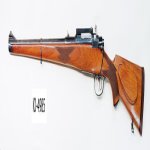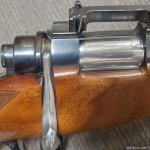You are using an out of date browser. It may not display this or other websites correctly.
You should upgrade or use an alternative browser.
You should upgrade or use an alternative browser.
Brno 22f Scope Ring Advice
- Thread starter Gun123
- Start date
The Kurgan
CGN Ultra frequent flyer
- Location
- Steel Town and The Peg
I've had very good luck with Warne high rings, QD variety.
Hello,
Who can advise me on what kind of 1" scope rings, available in Canada, that will work on a Brno 22f rifle, with double square bridges, and butter knife bolt handle modified?
Thanks
Sounds like an exceptional firearm.
Care to share a pic of your 21F
What caliber ?
Rob
Just looked for Warne QD for CZ550 and found none.I've had very good luck with Warne high rings, QD variety.
It's 7x57. Its being exported to Canada from the US. View attachment 646390
Looks nice...this is the second one I have seen.
Both on CGN.
Rob
The Kurgan
CGN Ultra frequent flyer
- Location
- Steel Town and The Peg
Check to see what Prophet has for CZ 550 / 557.
You will need something in "high".
You will need something in "high".
The Kurgan
CGN Ultra frequent flyer
- Location
- Steel Town and The Peg
btw, I'm jealous. Beautiful rifle.
It really is a beautiful rifle. It'll be imported by Irunguns in its next shipment. I can't wait to have it in my hands. Pictures are all i've got of this rifle at the moment. The picture I shared was taken before packing for shipping.
Warne QD 1" rings are all sold out, but I will keep looking. Prophet River carries Tally rings that i will also consider. As far as I can tell from the photos, the bolt had been altered for scope clearance. Medium height rings may work. I will know for sure when i have received the rifle.
Warne QD 1" rings are all sold out, but I will keep looking. Prophet River carries Tally rings that i will also consider. As far as I can tell from the photos, the bolt had been altered for scope clearance. Medium height rings may work. I will know for sure when i have received the rifle.
- Location
- Western Manitoba
OP - I am not sure how many scopes that you have mounted? Need something for base, something for ring and something for scope - all of them vary. That picture of rifle that you show (Post #4) has what I think is Leupold or Redfield one-piece base - meaning only that kind of ring will fit to that base - I do not recall older Redfield model, but I think current Leupold is "STD" series - the rings for those come in multiple heights. The Redfield and Leupold rings and bases (of the same type) seem to interchange just fine.
Or, maybe you want to replace that base to use slotted bases - different kind of rings used, need bases specifically made for that rifle. Is / was several CZ rifles (and others) made with "integral" bases - so scope mount bases were milled as part of the receiver - I think was unique rings to be used - only on those integral bases? Is various widths used on various rifles - so my BRNO No. 1 has 16 mm dovetails, one CZ452 has 3/8" dovetails, another has 11 mm dovetails - I think was SAKO that made taper bases for their rings. It was my impression that "square bridge" was to create integral bases to the receiver, but I have never owned one. If installing separate bases onto a "double square bridge" - kind of defeating the point of the design?
Is both ends of your scope to be concerned about clearance - front end bell might run into something (like the barrel), or various power change ring or eye piece might run into bolt handle - so can end up using different height rings, on same rifle, with different scopes. Or get very high rings and use same for all scopes.
I forgot to mention - is also various diameters of scope body - pretty common in North America today to be 1 inch (25.4 mm) or 30 mm diameter. Is also various European scopes with 26 mm diameter bodies - so at least three diameters of rings - maybe see something to buy is correct height, and base, but you will also want to check what scope body diameter it has. In olden days, was also 7/8" and 3/4" body scopes, but not sure if many of those are come across these days.
Or, maybe you want to replace that base to use slotted bases - different kind of rings used, need bases specifically made for that rifle. Is / was several CZ rifles (and others) made with "integral" bases - so scope mount bases were milled as part of the receiver - I think was unique rings to be used - only on those integral bases? Is various widths used on various rifles - so my BRNO No. 1 has 16 mm dovetails, one CZ452 has 3/8" dovetails, another has 11 mm dovetails - I think was SAKO that made taper bases for their rings. It was my impression that "square bridge" was to create integral bases to the receiver, but I have never owned one. If installing separate bases onto a "double square bridge" - kind of defeating the point of the design?
Is both ends of your scope to be concerned about clearance - front end bell might run into something (like the barrel), or various power change ring or eye piece might run into bolt handle - so can end up using different height rings, on same rifle, with different scopes. Or get very high rings and use same for all scopes.
I forgot to mention - is also various diameters of scope body - pretty common in North America today to be 1 inch (25.4 mm) or 30 mm diameter. Is also various European scopes with 26 mm diameter bodies - so at least three diameters of rings - maybe see something to buy is correct height, and base, but you will also want to check what scope body diameter it has. In olden days, was also 7/8" and 3/4" body scopes, but not sure if many of those are come across these days.
Last edited:
yes. I will remove the Redfield one piece base. I will prefer to use quick detachable rings that will allow me to use the iron sights by quick removal of the scope. That's why I am leaning toward Warne qd rings for brno rifles. I have a couple of 1" Leupold scopes that I will try to put on this rifle.
Last edited:
- Location
- Western Manitoba
OP - I think go to Brownell's catalogue on-line (website) - they often give a dimension in thousandths of inch from top of scope base to either bottom of scope body or centre of the scope tube - for the various rings that they sell - you will discover that "Low", "Medium" and "High" are words used by most scope ring makers, but many are different heights - a "Low" Weaver is not usually the same height as a "Low" Leupold - and could be different among Leupold STD or what they currently list as "Back Country" - I do not know for sure if there is a difference among those last two - I prefer to work with actual dimension, not words like "Low" or "Medium".
Will also be something to fuss about - length of your scope and the location of that rear sight - I do not think that rear one folds down - so your scope may need to be mounted tall enough to sit above it, or short enough scope to fit behind it - makes difference what OD of your Objective end is - can see various scopes - 56 to 20 mm front lens - really large differences in front objective diameter.
And I do notice in picture on your Post #15 that appears that the rear integral base has been drilled and tapped for scope base hole - to screw a conventional base on top - I presume so has front - so you will need to find bases that fit to that rifle, for the rings that you intend to use, for the scope that you intend to use. I have not seen Warne QD rings for attaching to that rifle's integral scope bases - but maybe they do make them? Might be why previous owner went with the drill and tap thing??
Is another thing - is easily 3 or 4 DOZEN used rings here of various brands, heights and base types - so when dealing with a particular rifle and a particular scope, is not uncommon to try several to see what it is that I want to order. I am not sure that I would know how to do that if I only had that one rifle and one scope here. I had read of ways to "mock up" using modelling clay, wood shims, etc. - to find height (in thousandths of an inch) that would likely work. Is very typical - almost a "rule" - that the rings are same height each other - bases are often different thickness - but when correct, the top face of the bases make a dead flat plane - usually parallel with bore centre line - or slightly tipped forward - but "flat" to each other.
Will also be something to fuss about - length of your scope and the location of that rear sight - I do not think that rear one folds down - so your scope may need to be mounted tall enough to sit above it, or short enough scope to fit behind it - makes difference what OD of your Objective end is - can see various scopes - 56 to 20 mm front lens - really large differences in front objective diameter.
And I do notice in picture on your Post #15 that appears that the rear integral base has been drilled and tapped for scope base hole - to screw a conventional base on top - I presume so has front - so you will need to find bases that fit to that rifle, for the rings that you intend to use, for the scope that you intend to use. I have not seen Warne QD rings for attaching to that rifle's integral scope bases - but maybe they do make them? Might be why previous owner went with the drill and tap thing??
Is another thing - is easily 3 or 4 DOZEN used rings here of various brands, heights and base types - so when dealing with a particular rifle and a particular scope, is not uncommon to try several to see what it is that I want to order. I am not sure that I would know how to do that if I only had that one rifle and one scope here. I had read of ways to "mock up" using modelling clay, wood shims, etc. - to find height (in thousandths of an inch) that would likely work. Is very typical - almost a "rule" - that the rings are same height each other - bases are often different thickness - but when correct, the top face of the bases make a dead flat plane - usually parallel with bore centre line - or slightly tipped forward - but "flat" to each other.
Last edited:
The Kurgan
CGN Ultra frequent flyer
- Location
- Steel Town and The Peg
It really is a beautiful rifle. It'll be imported by Irunguns in its next shipment. I can't wait to have it in my hands. Pictures are all i've got of this rifle at the moment. The picture I shared was taken before packing for shipping.
Warne QD 1" rings are all sold out, but I will keep looking. Prophet River carries Tally rings that i will also consider. As far as I can tell from the photos, the bolt had been altered for scope clearance. Medium height rings may work. I will know for sure when i have received the rifle.
No matter what, you will need to go with high rings, or higher. Trust me, I've scoped a few!
My next Brno will also be a 22F, and it will only get a NECG rear peep site!
If you insist on scoping, consider having Gunco fit you a standard M98 bolt with a proper turned down handle, or, since your bolt handle is already altered, consider Gunco doing a cut and weld job. Much less headache at the end of the day.
OP - I think go to Brownell's catalogue on-line (website) - they often give a dimension in thousandths of inch from top of scope base to either bottom of scope body or centre of the scope tube - for the various rings that they sell - you will discover that "Low", "Medium" and "High" are words used by most scope ring makers, but many are different heights - a "Low" Weaver is not usually the same height as a "Low" Leupold - and could be different among Leupold STD or what they currently list as "Back Country" - I do not know for sure if there is a difference among those last two - I prefer to work with actual dimension, not words like "Low" or "Medium".
Will also be something to fuss about - length of your scope and the location of that rear sight - I do not think that rear one folds down - so your scope may need to be mounted tall enough to sit above it, or short enough scope to fit behind it - makes difference what OD of your Objective end is - can see various scopes - 56 to 20 mm front lens - really large differences in front objective diameter.
And I do notice in picture on your Post #15 that appears that the rear integral base has been drilled and tapped for scope base hole - to screw a conventional base on top - I presume so has front - so you will need to find bases that fit to that rifle, for the rings that you intend to use, for the scope that you intend to use. I have not seen Warne QD rings for attaching to that rifle's integral scope bases - but maybe they do make them? Might be why previous owner went with the drill and tap thing??
Is another thing - is easily 3 or 4 DOZEN used rings here of various brands, heights and base types - so when dealing with a particular rifle and a particular scope, is not uncommon to try several to see what it is that I want to order. I am not sure that I would know how to do that if I only had that one rifle and one scope here. I had read of ways to "mock up" using modelling clay, wood shims, etc. - to find height (in thousandths of an inch) that would likely work. Is very typical - almost a "rule" - that the rings are same height each other - bases are often different thickness - but when correct, the top face of the bases make a dead flat plane - usually parallel with bore centre line - or slightly tipped forward - but "flat" to each other.
Excellent points you made there. This is very helpful. Thanks very much.
No matter what, you will need to go with high rings, or higher. Trust me, I've scoped a few!
My next Brno will also be a 22F, and it will only get a NECG rear peep site!
If you insist on scoping, consider having Gunco fit you a standard M98 bolt with a proper turned down handle, or, since your bolt handle is already altered, consider Gunco doing a cut and weld job. Much less headache at the end of the day.
I may end up going to Gunco.
- Location
- Saskatchewan
Actually, that bolt is already cut and welded, and the stock notched for the lower bolt. The original bolt hugs the outside of the stock without any notch in the stock. I have two sets of Talley medium QD ringmounts that will work, both 30mm and 1". Shoot me a PM.

















































 Canadabrass has some in med and high but some options are sold out.
Canadabrass has some in med and high but some options are sold out.


























